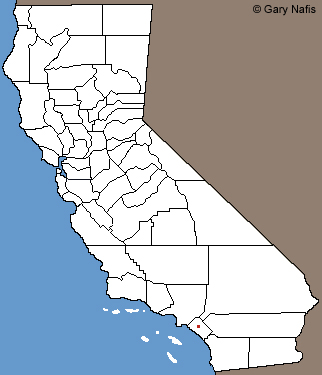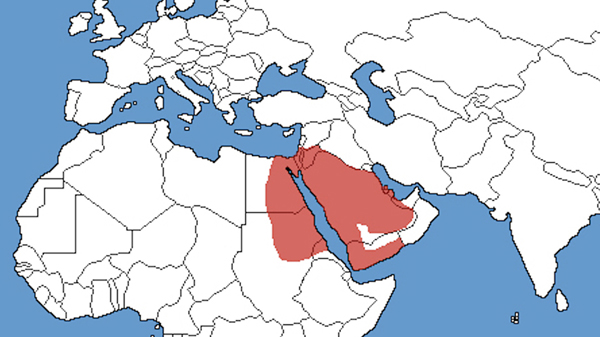 Red dot Red dot: Range in California
|
This species has been introduced into California. It is not a native species.
|
| |
 |
|
| |
© 2009 Frank Teigler
- CalPhotos |
|
| |
More pictures of this species can be viewed at
GeckoWeb
Wickipedia
The Reptile Database
iNaturalist
|
|
|
Description |
A slim nocturnal gecko
with long thin hind limbs and very large feet.
|
| Size |
Adults grow to a snout to vent length of 3.8 inches (96mm).
|
| Appearance |
Color is golden brown, cream, gray, tan, or pinkish, and at night appears almost white.
The body is marked with darker cross-bands and spots. The tail is banded.
The eyes are large without eyelids, and the pupils are vertical.
|
| Life History and Behaviors |
Nocturnal.
An excellent climber, able to climb on most surfaces, including ceilings.
Makes clicking vocalizations to communicate with other geckos.
Frequently found in the pet trade.
|
| Diet |
In its native range eats a variety of insects, spiders and scorpions.
|
| Reproduction and Young |
Oviparous - females lay a clutch of one or two eggs in crevices or other hidden locations.
|
| Habitat |
In its native range this species is found in rocky arid deserts, also utilizing human structures.
The lone California population is in an urban setting where they live on buildings.
|
| Distribution |
Presence in California
In their 2025 California field guide, p.167, Hansen and Shedd report that this species has been established in Orange County, California: "First observed in California in 2015 near a reptile-breeding facility." ... "A small but reproductively active population is restricted to an urban site in Santa Ana (Orange Co.; elev. less than 70 ft./21m)."
The 2025 SSAR scientific and common names list also lists the species as present in California based on the Hansen and Shedd book, but I have not yet been able to find any other reports of the species in the state. iNaturalist does not show them in Orange County nor does the H.E.R.P. database and I have not been able to find any museum records for the species from California. The Center for North American Herpetology has a California page for the species which is also based solely on Hansen and Shedd.
Native Range
Wickipedia reports the native range as northern Africa and western Asia, including "Algeria, Cameroon, Egypt, Eritrea, eastern Ethiopia, Iraq, Israel, Jordan, Lebanon, Saudi Arabia (including the Farasan Islands), northern Somalia, Sudan, and Syria."
|
 |
Red: Native range
|
| Taxonomic Notes |
Two subspecies are recognized:
Ptyodactylus hasselquistii hasselquistii (Donndorff, 1798)
Ptyodactylus hasselquistii krameri Y. Werner, 1995 – Kramer's yellow fan-fingered gecko
|
| Conservation Issues (Conservation Status) |
None none yet, but any introduced species can have a negative impact by competing for food and resources with native species.
|
|
Taxonomy |
| Family |
Phyllodactylidae |
Leaf-toed Geckos |
Gamble et al., 2008 |
| Genus |
Ptyodactylus |
Fan-fingered Geckos
|
Goldfuss, 1820 |
Species
|
hasselquistii |
Yellow Fan-fingered Gecko |
(Donndorff, 1798) |
|
Donndorff, 1798
|
|
The word Ptyodactylus is derived from
Ptyo - a Greek verb meaning "to spit" or "to spit out" - possibly referring to the way the toes are splayed out and
the Greek word dactylos - meaning "finger." or "toe." In biology, "dactyl" refers to a finger or toe.
hasselquistii:
The Reptile Database reports that this species is "named after Frederic Hasselquist, Swedish physician and explorer and student of Carl von Linné (Adler 2012)."
GeckoWeb explains that the common name is derived from the "distinctive split, fan-like shape of their toepads, which extend beyond the claws."
|
|
Fan-footed Gecko
Hasselquist's Fan-footed Gecko
Synonyms:
Lacerta hasselquistii Donndorff, 1798
Gecko ascalabotes Merrem, 1820
Gecko lobatus Lichtenstein, 1823
Ptyodactylus lobatus — Gray, 1825
Ptyodactylus hasselquistii — A.M.C. Duméril & Bibron, 1836
|
Related or Similar Native and Non-native California Herps
|
Peninsular Leaf-toed Gecko - Phyllodactylus nocticolus
Non-native geckos in California
Rough-tailed Gecko - Cyrtopodion scabrum
Common House Gecko - Hemidactylus frenatus
Indo-Pacific Gecko - Hemidactylus garnotii
Tropical House Gecko - Hemidactylus mabouia
Flat-tailed House Gecko - Hemidactylus platyurus
Mediterranean Gecko - Hemidactylus turcicus
Yellow Fan-Fingered Gecko - Ptyodactylus hasselquistii
Ringed Wall Gecko - Tarentola annularis
Moorish Gecko - Tarentola mauritanica
|
More Information and References
|
Hansen, Robert W. and Shedd, Jackson D. California Amphibians and Reptiles. (Princeton Field Guides.) Princeton University Press, 2025
GeckoWeb
Wickipedia
The Reptile Database
iNaturalist
The Center for North American Herpetology
|
|
|
The following conservation status listings for this animal are taken from the July 2025 State of California Special Animals List and the July 2025 Federally Listed Endangered and Threatened Animals of California list (unless indicated otherwise below.) Both lists are produced by multiple agencies every year, and sometimes more than once per year, so the conservation status listing information found below might not be from the most recent lists, but they don't change a great deal from year to year.. To make sure you are seeing the most recent listings, go to this California Department of Fish and Wildlife web page where you can search for and download both lists:
https://www.wildlife.ca.gov/Data/CNDDB/Plants-and-Animals.
A detailed explanation of the meaning of the status listing symbols can be found at the beginning of the two lists. For quick reference, I have included them on my Special Status Information page.
If no status is listed here, the animal is not included on either list. This most likely indicates that there are no serious conservation concerns for the animal. To find out more about an animal's status you can also go to the NatureServe and IUCN websites to check their rankings.
Check the current California Department of Fish and Wildlife sport fishing regulations to find out if this animal can be legally pursued and handled or collected with possession of a current fishing license. You can also look at the summary of the sport fishing regulations as they apply only to reptiles and amphibians that has been made for this website.
|
| Organization |
Status Listing |
Notes |
| NatureServe Global Ranking |
|
|
| NatureServe State Ranking |
|
|
| U.S. Endangered Species Act (ESA) |
None |
|
| California Endangered Species Act (CESA) |
None |
|
| California Department of Fish and Wildlife |
None |
|
| Bureau of Land Management |
None |
|
| USDA Forest Service |
None |
|
| IUCN |
|
|
|
|




